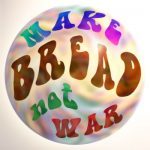What do you think?
Rate this book


176 pages, Hardcover
First published September 1, 2016
[T]he Campaign for Real Bread that ran in Britain in the 1970s turned into the 1980s, the fight for better bread is perhaps as old as bread itself. [The Fight For Better Bread]
A gentle answer turns away wrath, but a harsh word stirs up anger. - Proverbs 15:1
[O]ne option is simply to leave it on the work surface and cover with a large mixing bowl. Another is to put the dough into a large bowl and cover with a damp, clean dish towel, large elasticated bowl cover or shower cap. Alternatively, you can slip the bowl into a reusable plastic bag that's large enough to be sealed around it. I try to avoid anything that's single-use, such as cling film/plastic wrap. [Terms and Techniques | Cover]
The amount of flour you use isn't important so we've started small, as instructions that tell you to throw portions of your starter away just seem wasteful. [...] the liquid (sometimes known as "hooch") will have started to become alcoholic, which can slow the starter down [Sourdough Starter]
When you think about it, the things you actually need to make Real Bread are few. The only truly essential bits of kit for making most Real Bread are your hands, a work surface, an oven and something to put the dough in or on for baking. [Equipment]
Without getting too scientific, yeast cells produce an enzyme that breaks some of the starch in flour down into simpler sugars, which they then metabolize in order to grow and reproduce. One by-product of this is the carbon dioxide that makes dough rise. [Terms and Techniques]
In the first few moments of baking, loaves swell rapidly (this is called "oven spring") and can rupture, which is known as a burst. Bursting can be useful in helping to have an open (rather than tight or close) crumb structure, but it can happen at random and not necessarily in an attractive way. For a note on controlling bursting, see Slashing on pages 21-22. [Terms and Techniques]
This unusual loaf is made using trub, the yeasty sediment (or lees) found at the bottom of beer-fermenting vessels. So it's for the home brewer, or readers who know a tame brewer who will give them some trub for their starter. Try cutting the top off the trencher and using each half as a plate, or maybe just tear off chunks and enjoy with good butter, a hunk of proper cheese and a glass of the real ale it was made with. [Trub Trencher - Chris Young]
Medieval bread trenchers were typically stale pieces sliced from coarse, dense loaves. This meant they were solid enough to use as tableware and not disintegrate even soaked in gravy or sauces. Still tough after the meal, used trenchers might be given to animals or the poor, as surely only a real trencherman would eat his own...


More reviews (and no fluff) on the blog http://surrealtalvi.wordpress.com/
Slow Dough Real Bread is a beautifully presented and easy to follow cookbook featuring bread recipes from around the world. Whether a Finnish pulla, San Francisco sourdough, or Istanbul breakfast bread, the list is quite comprehensive.